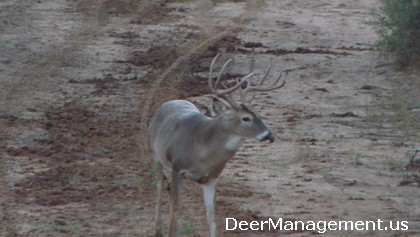Deer Habitat Management Question
Question: “We have a ranch in South Texas and are attempting whitetail deer management. We have some rolling topography with a lot of variation in plants. On hill tops there is a lot of blackbrush, guajillo, and mountain laurel. I know from doing some research on the food habits on deer that mountain laurel or sage brush is not consumed by deer.
So what can I do to make this area better and manage for deer? Can I eliminate unwanted brush through chemical application or should I consider some type of mechanical removal? We have some hilltop areas with these low value plants that I would like to manage. Any ideas?”
Deer Habitat Management Considerations
Deer Management: The best thing that a land manager interested in whitetail deer management can do with plants growing on poor soil is absolutely nothing. That’s right, just leave the area alone, at least for the most part. Poor soils are not going to grow much, but will produce warm season and cool season forbs when it rains.
The areas you described provide good summertime bedding areas for whitetail. This type of habitat is seasonally important. Deer love to get up on the high spots on windy days to escape biting flies and rest. An area exposed to the wind helps deer with thermoregulation (staying cool!) and Texas heat is no joke.

Sometimes habitat management for the sake of deer means thinking small. Plants such as purple sage and mountain laurel grow in some of the thinnest and least-productive soils in West and South Texas. If you went in an pushed these areas the removal of these plants that provide screening habitat would leave you devoid of vegetation, until the sage and laurel grow back.
This would also leave the soil open for wind and water erosion. The best habitat management recommendation I could give you would be to do nothing major with these areas. This is based simply on weighing risk versus reward.
Habitat Manipulation for Deer
These areas can be manipulated for deer though. Think about shredding a pass or two through the sage so that you can see into it as you drive the ranch. You will see deer. One of the land managers I know in South Texas manages these areas for deer by cutting senderos (linear openings) and maintaining those openings about every other year.
The resulting regrowth black brush and guajillo enhance habitat by providing good food sources. The openings provide great forbs and the right times of the year. The senderos also allow whitetail travel through that thick stuff. Deer love these areas! Creating openings in woodlands or shrublands will work everywhere within the whitetail’s range.
On any property, focus brush management efforts over the better quality soils for maximum benefit in both time and energy. On South Texas ranches, this often means clearing flood-prone areas or old CRP land with better soils. These can be shredded and plowed in late winter just in time for spring forb growth.
These sites will provide natural foods when the area gets seasonal rains. Whitetail deer will hit these food sources heavily, which provide high quality nutrition. Whenever managing plant communities found over poor soils, think small when it comes to deer management. Leave most of the stuff in place and manipulate only a portion of it. Don’t start over—just make it better.